Impact of Lubricating Oil Leakage Characteristics of a Bearing Cavity Sealing System Based on an Oil–Gas Two-Phase Flow
Abstract
1. Introduction
2. Numerical Method for the Sealing System of the Bearing Cavity
2.1. Oil–Gas Two-Phase Governing Equation
- Two-phase mixture model
- 2.
- Continuity equation
- 3.
- Momentum equation
- 4.
- Energy equation
- 5.
- Turbulent flow model
2.2. Numerical Method Validation
2.2.1. Oil Leakage Characteristic Test Device
2.2.2. Experimental Principles
2.2.3. Simulation Model, Mesh and Boundary Conditions
2.2.4. Comparison Validation
3. Characteristic Analysis of the Bearing Cavity Sealing System
3.1. Geometric Model
3.2. Grid Division and Boundary Conditions
3.3. Analysis of the Transient Characteristics of the Oil–Gas Two-Phase Flow Field in the Bearing Cavity
3.4. Lubricating Oil Leakage Characteristics
3.4.1. Analysis of the Oil Leakage Characteristics of the Conventional Bearing Cavity Sealing System
- Effect of sealing width on oil leakage characteristics
- 2.
- Effect of rotate speed on oil leakage characteristics
3.4.2. Analysis of the Lubricating Oil Leakage Characteristics of the Graphite with Oil-Return Groove Bearing Cavity Sealing System
- Impact of oil-return groove on the lubricating oil leakage characteristics
- 2.
- Impact of oil-return groove length on the lubricating oil leakage characteristics
- 3.
- Impact of oil-return groove width on the lubricating oil leakage characteristics
- 4.
- Impact of the number of oil-return grooves on the leakage characteristics of the lubricating oil
- 5.
- Impact of oil-return groove parameters on the mean value of oil leakage
3.5. Critical Sealing Oil Characteristics
4. Conclusions
- With time, the lubricating oil in the sealing cavity gradually increased.
- For the conventional bearing cavity sealing system, the change in sealing width has no obvious effect on the oil leakage, and the oil leakage is approximately 10 g/s. The oil leakage increases with speed. At 0 r/min, the oil leakage is less than 0.5 g/s, and at 15,000 r/min, the oil leakage is less than 10 g/s.
- Under the working condition of 1 kPa, the oil leakage of the graphite with oil-return groove structure reduced. The oil leakage decreases by 87.6% at 1 s, 82.3% at 2 s, and 98.1% at 3 s. Furthermore, the length and number of oil-return groove increased, and the leakage of lubricating oil decreased. The effect of change in the width of the oil-return groove on oil leakage is negligible.
- The critical sealing pressure difference of the conventional bearing cavity sealing system is 15~16 kPa when the rotate speed is 9000 r/min, and the critical sealing pressure difference is 16~17 kPa when the rotate speed is 15,000 r/min. The critical sealing pressure difference of the bearing cavity sealing system with oil-return groove graphite is 1~1.5 kPa when the rotate speed is 9000 r/min, and the critical sealing pressure difference is 1.5~2.0 kPa when the rotate speed is 15,000 r/min. Under the same working conditions, the critical sealing oil pressure difference of the graphite with oil-return groove bearing cavity sealing system is more than 90% lower than that of the conventional bearing cavity sealing system.
Author Contributions
Funding
Data Availability Statement
Acknowledgments
Conflicts of Interest
References
- Attia, H.A.; Chandra, B.; Toomer, C. Computational and experimental representation of simplified gas turbine bearing chamber geometries. Int. J. Thermofluids 2025, 26, 101097. [Google Scholar] [CrossRef]
- Xu, Y.; Hu, J.; Lyu, Y.; Liu, Z. Experimental study of shear-driven film flows in aeroengine bearing chamber. J. Braz. Soc. Mech. Sci. Eng. 2025, 47, 171. [Google Scholar] [CrossRef]
- Farrall, M.; Hibberd, S.; Simmons, K. The Effect of Initial Injection Conditions on the Oil Droplet Motion in a Simplified Bearing Chamber. ASME J. Eng. Gas Turbines Power 2008, 130, 012501. [Google Scholar] [CrossRef]
- Farrall, M.; Simmons, K.; Hibberd, S.; Gorse, P. A Numerical Model for Oil Film Flow in an Aeroengine Bearing Chamber and Comparison to Experimental Data. ASME J. Eng. Gas Turbines Power 2006, 128, 111–117. [Google Scholar] [CrossRef]
- Chen, B.; Chen, G.D.; Sun, H.C.; Zhang, Y.H. Effect of oil droplet deformation on its deposited characteristics in an aeroengine bearing chamber. Proc. Inst. Mech. Eng. Part G J. Aerosp. Eng. 2014, 228, 206–218. [Google Scholar] [CrossRef]
- Li, Y.; Li, R.; Tian, A.; Xu, X.; Zhang, H. Research on leakage characteristics of labyrinth seal based on air-oil two-phase flow. Multidiscip. Model. Mater. Struct. 2025, 21, 270–290. [Google Scholar] [CrossRef]
- Aissa, D.O.H.; Lysytsia, O.; Mykhailenko, T.; Petukhov, I. CFD modeling of multiphase flows in the gas turbine engines oil cavities. East.-Eur. J. Enterp. Technol. 2020, 2, 104. [Google Scholar] [CrossRef]
- Ren, G.; Li, Y.; Zhao, H.; Yan, Y.; Xu, W.; Sun, D. Research on Oil–Gas Two-Phase Flow Characteristics and Improvement of Aero-Engine Bearing Chamber. Lubricants 2023, 11, 360. [Google Scholar] [CrossRef]
- Li, S.; Li, C.; Wang, W. Simulation of Unsteady Flows of Oil/Gas in the Ventless Bearing Chamber of an Aero-Engine. Aerospace 2022, 9, 211. [Google Scholar] [CrossRef]
- Farrall, M.; Simmons, K.; Hibberd, S.; Gorse, P. A numerical model for oil film flow in an aero-engine bearing chamber and comparison with experimental data. In Proceedings of the ASME Turbo Expo: Power for Land, Sea, and Air, Vienna, Austria, 14–17 June 2004; pp. 409–417. [Google Scholar] [CrossRef]
- Wen, B.; Li, Y.; Li, Y.; Wang, M.; Zhai, J. Influence and Optimization of Nozzle Position on Lubricant Distribution in an Angular Contact Ball Bearing Cavity. Lubricants 2024, 12, 419. [Google Scholar] [CrossRef]
- Li, J.; Qu, B.; Qian, Y.; Liu, Z.; Li, Z. Identification of Oil and Gas Two-Phase Flow Patterns in Aero-Engine Bearing Chambers Based on Kriging Method. Int. J. Comput. Fluid Dyn. 2023, 37, 316–332. [Google Scholar] [CrossRef]
- Lu, P.; Fang, L.; Wang, X.; Wang, Q.; Zhang, J. Influences of the Geometry of the Scavenge Pipe on the Air-Oil Two-Phase Flow and Heat Transfer in an Aero-Engine Bearing Chamber. ACS Omega 2019, 4, 15226–15233. [Google Scholar] [CrossRef] [PubMed]
- Adeniyi, A.A.; Morvan, H.P.; Simmons, K.A. A Transient CFD Simulation of the Flow in a Test Rig of an Aeroengine Bearing Chamber. In Volume 5C: Heat Transfer, Proceedings of the ASME Turbo Expo 2014: Turbine Technical Conference and Exposition, Düsseldorf, Germany, 16–20 June 2014; ASME: New York, NY, USA, 2014. [Google Scholar] [CrossRef]
- Arghir, M.; Mariot, A. Theoretical analysis of the static characteristics of the carbon segmented seal. J. Tribol. Trans. ASME 2017, 139, 062202. [Google Scholar] [CrossRef]
- Tam, L.T.; Przekwas, A.J.; Muszynska, A.; Hendricks, R.C.; Braun, M.J.; Mullen, R.L. Numerical and analytical study of fluid dynamic forces in seals and bearings. J. Vib. Acoust. 1988, 110, 315–325. [Google Scholar] [CrossRef]
- Duan, W.; Chu, F.; Kim, C.H.; Lee, Y.B. A bulk-flow analysis of static and dynamic characteristics of floating ring seals. Tribol. Int. 2007, 40, 470–478. [Google Scholar] [CrossRef]
- Zhou, X.; Chen, C.; Li, J.; Wu, Y. Study on Radial Clearance Sealing Performance of Graphite Ring. J. Press. Vessel. Technol. 2021, 143, 031703. [Google Scholar] [CrossRef]
- Gao, B.C.; Meng, X.K.; Shen, M.X.; Peng, X.D. Transient thermal-mechanical coupling behavior analysis of mechanical seals during start-up operation. IOP Conf. Ser. Mater. Sci. Eng. 2016, 129, 012025. [Google Scholar] [CrossRef]
- Xue, B.; Wei, C.; Hu, J.B. Study of separation characteristics of micro-groove rotary seal considering different cavitation boundary conditions. Tribol. Lett. 2017, 65, 119. [Google Scholar] [CrossRef]
- Li, Z.; Li, Y.; Cao, H.; Hao, M.; Liu, F.; Meng, D. Investigation of cavitation evolution and hydrodynamic performances of oil film seal with spiral groove. Tribol. Int. 2021, 157, 106915. [Google Scholar] [CrossRef]
- Ren, G.Z.; Li, Y.P.; Zhao, H.; Xu, W.; Sun, D.; Yan, Y. Research on leakage flow characteristics of bearing chamber sealing system based on oil-gas two-phase flow. J. Aerosp. Power 2024, 40, 20230471. [Google Scholar] [CrossRef]
- Guo, J.; Zhao, H.; Wang, P.; Sun, D.; Wang, S. Numerical and Experimental Study on Oil-air Two-phase, Eakage Flow Characteristics Based on Air-bleeding Oil-sealing Mode in Seal Clearance of Bearing Cavity. J. Mech. Eng. 2024, 60, 214–225. [Google Scholar] [CrossRef]
- Ren, G.; Tang, H.; Yan, Y.; Xu, W.; Sun, D. Study on Oil Flow and Leakage Characteristics of Bearing Chamber Graphite Sealing Structure Considering Cavitation Effect. J. Aerosp. Power 2025. [Google Scholar] [CrossRef]
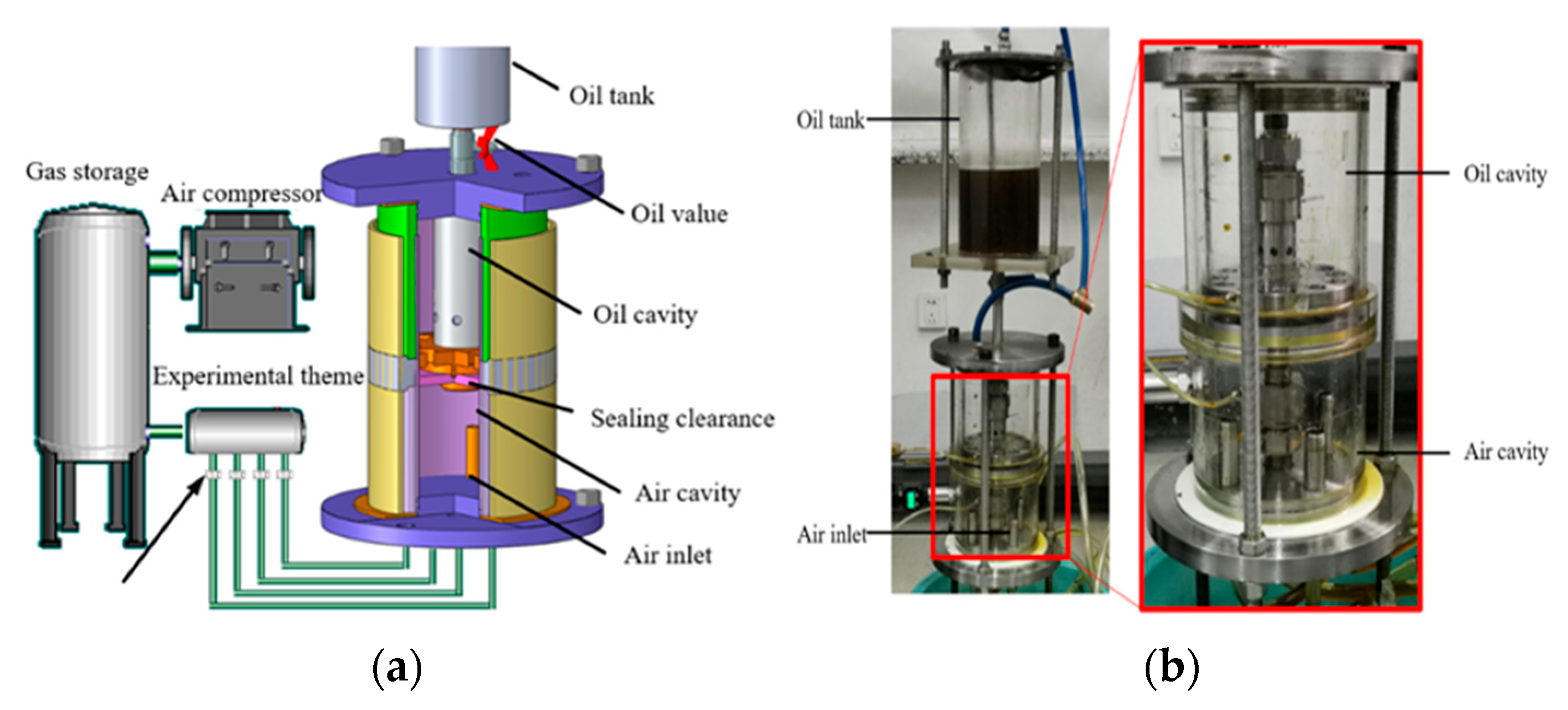
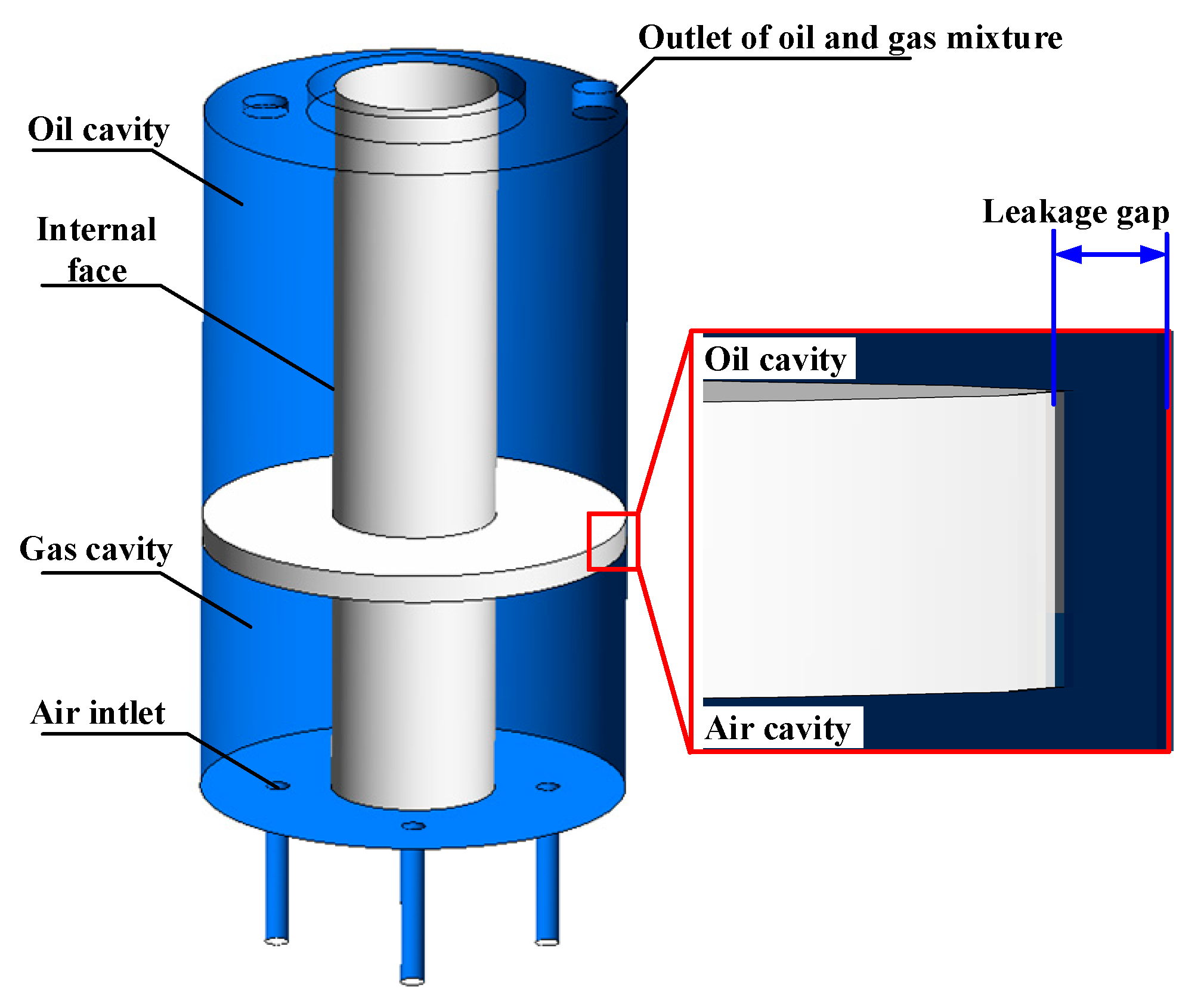


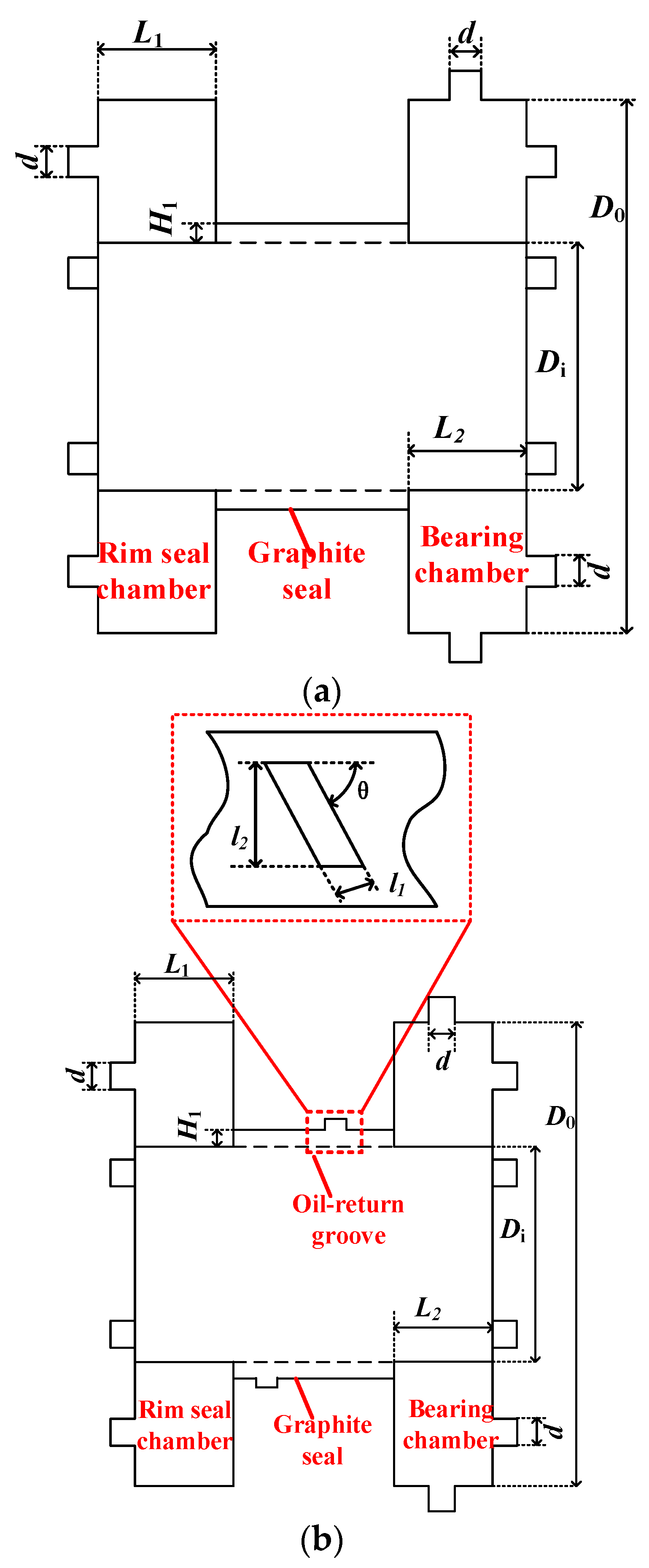
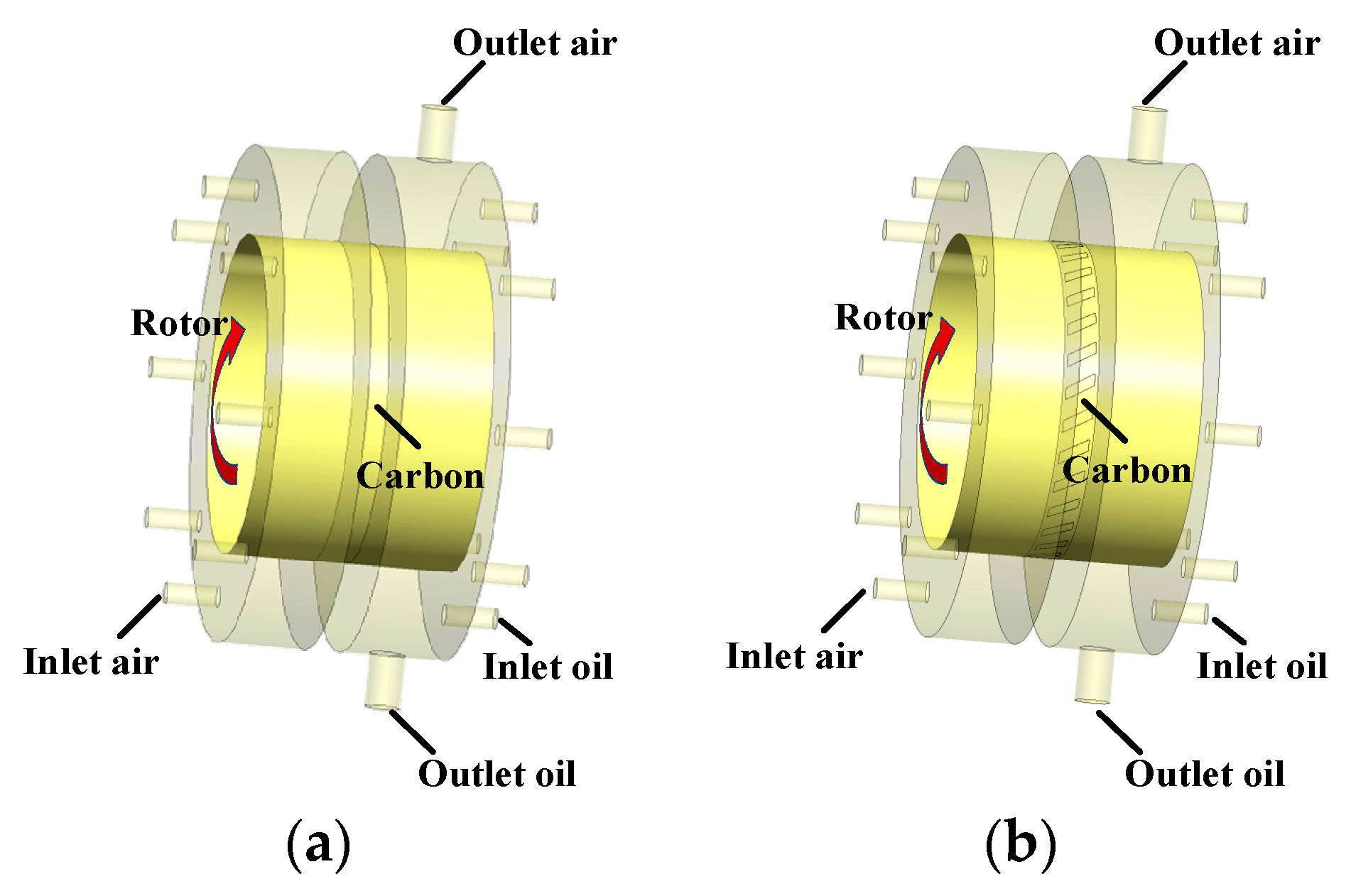
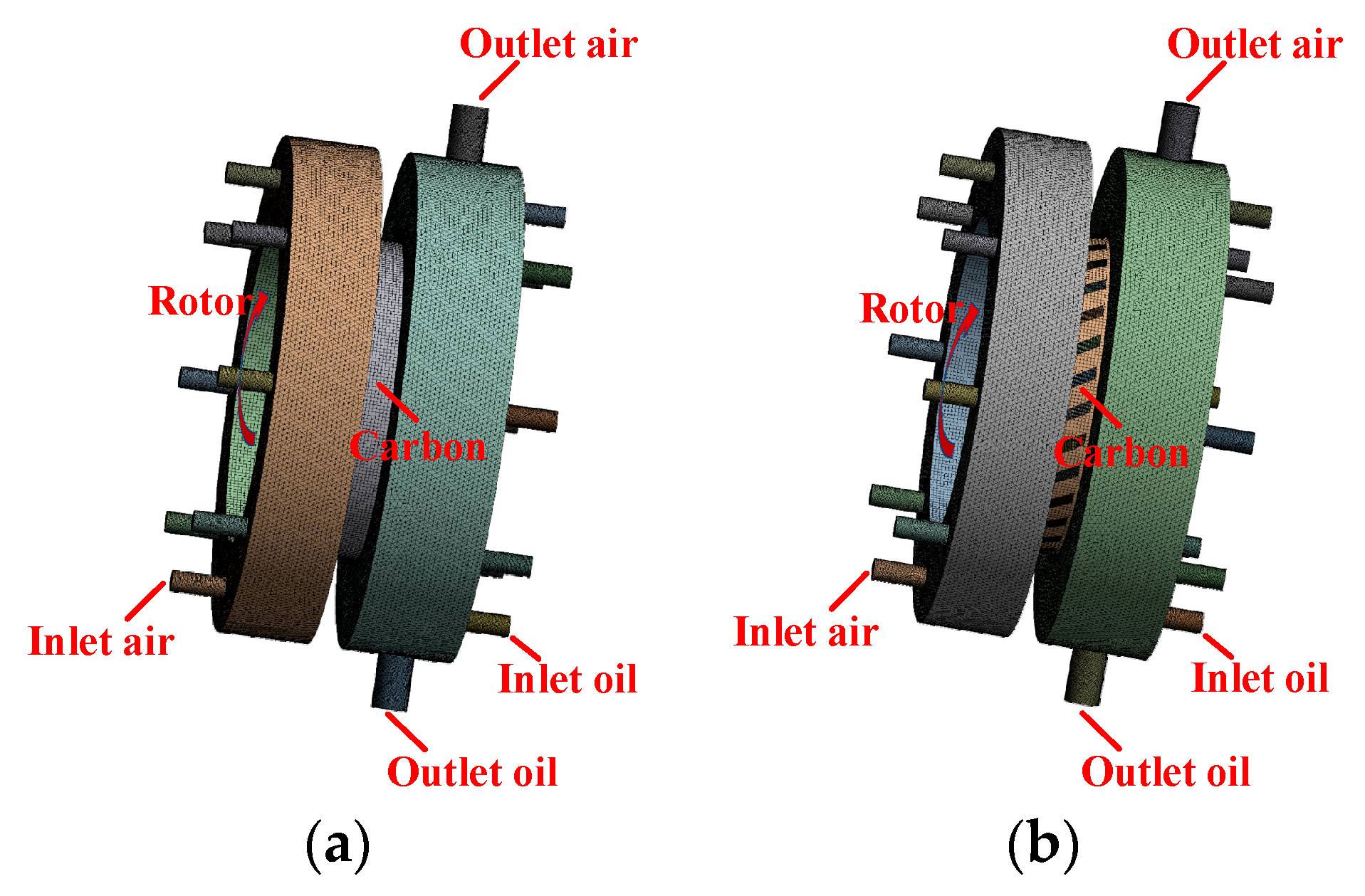
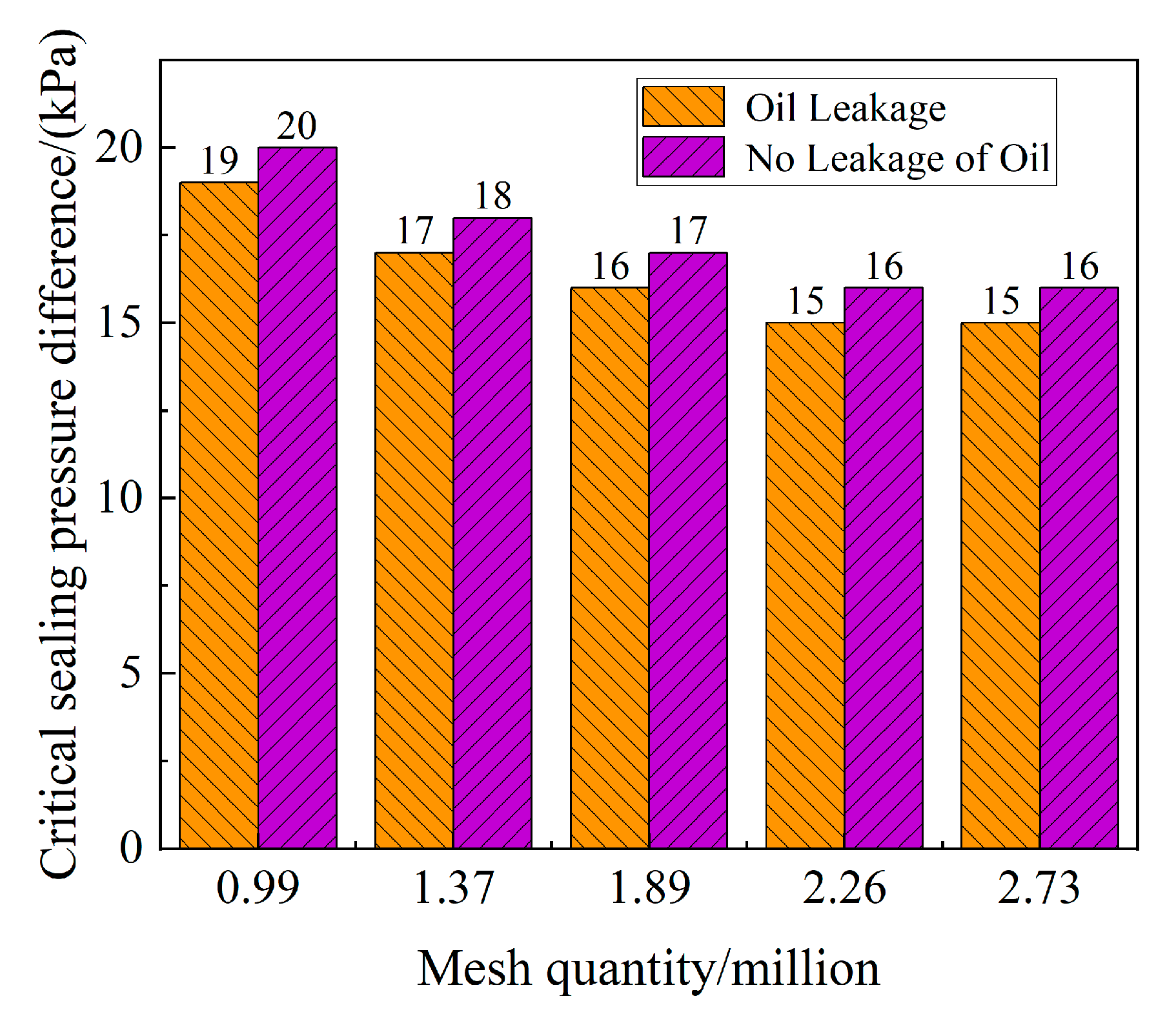
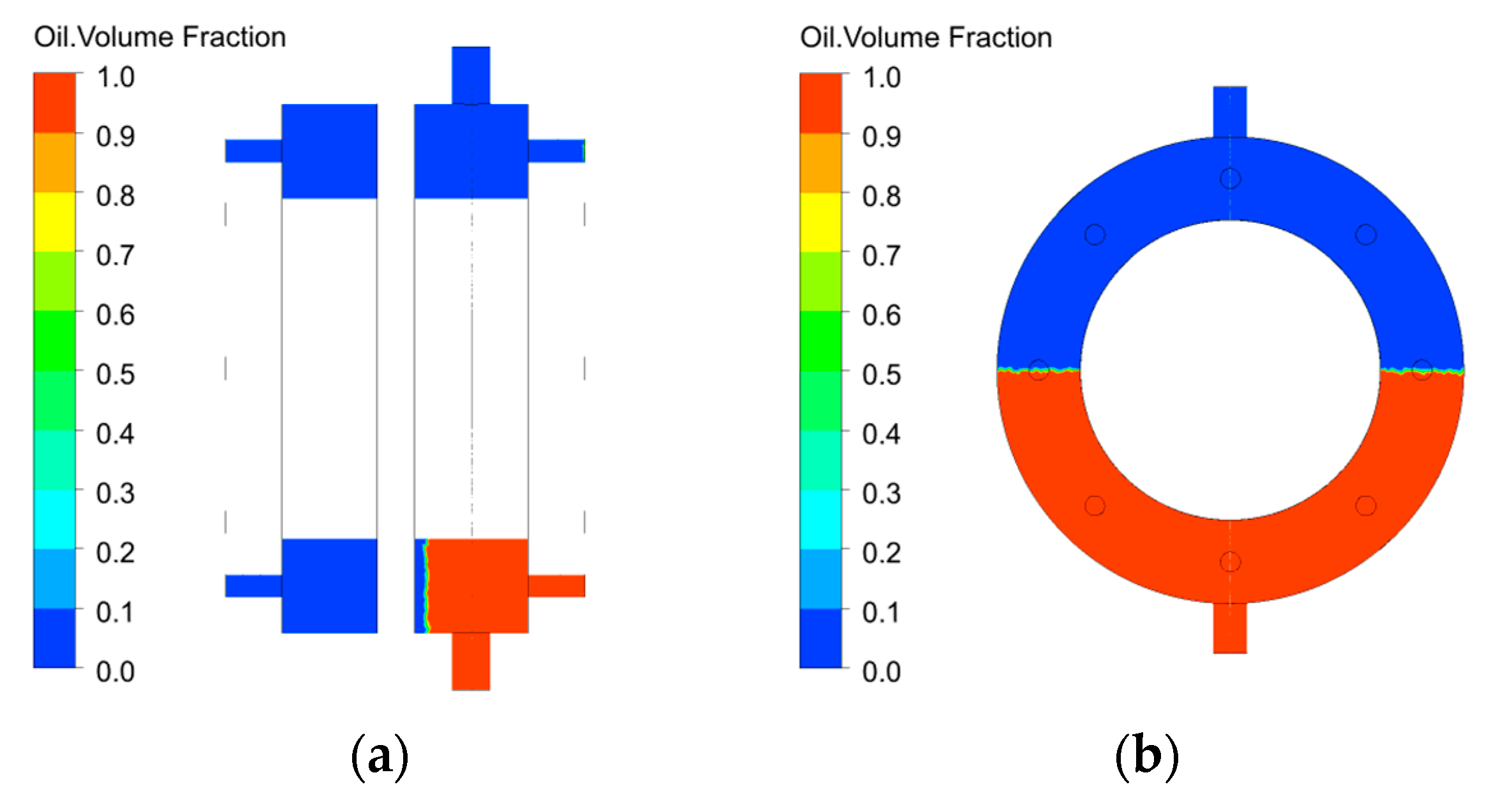
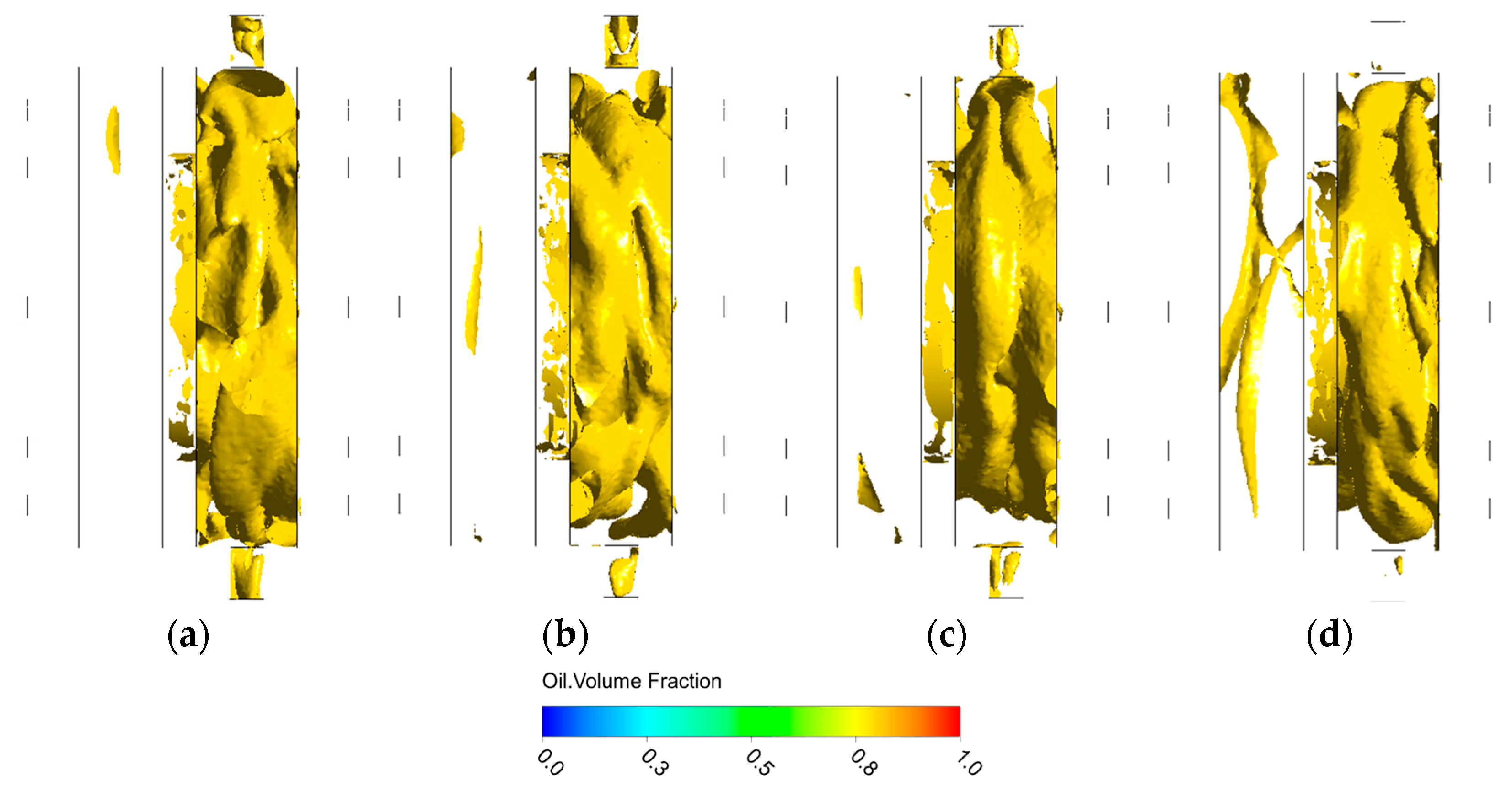
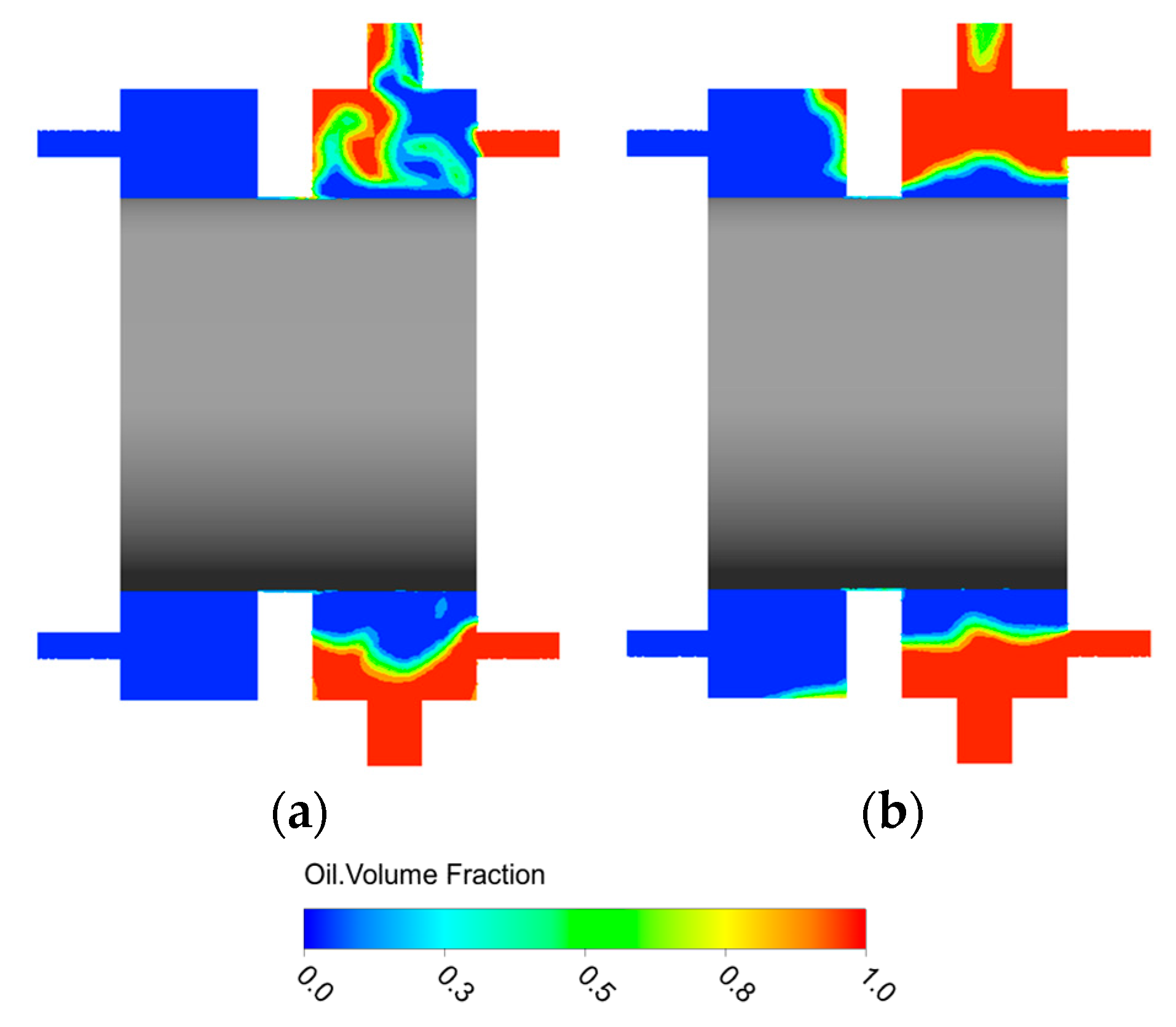
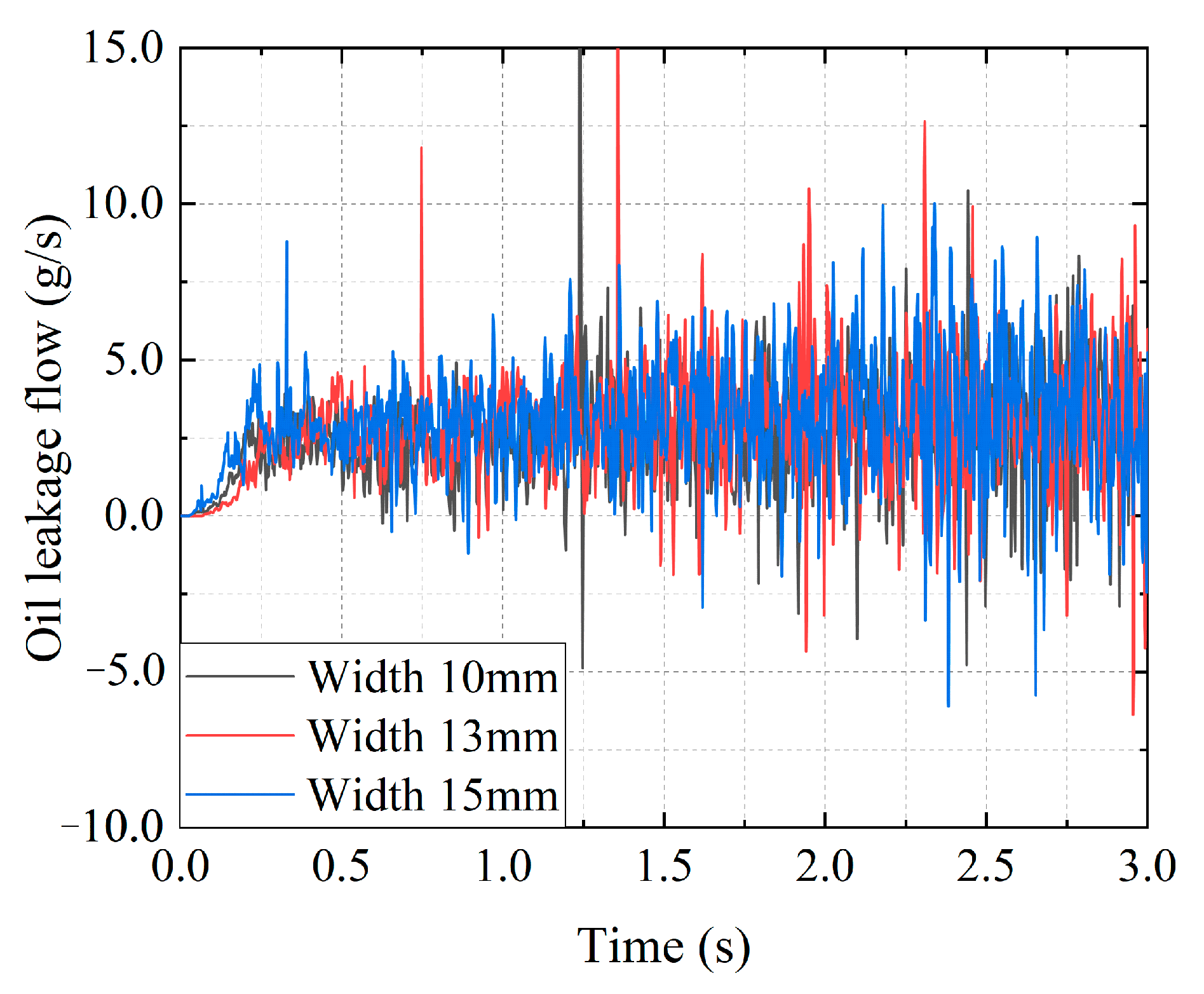
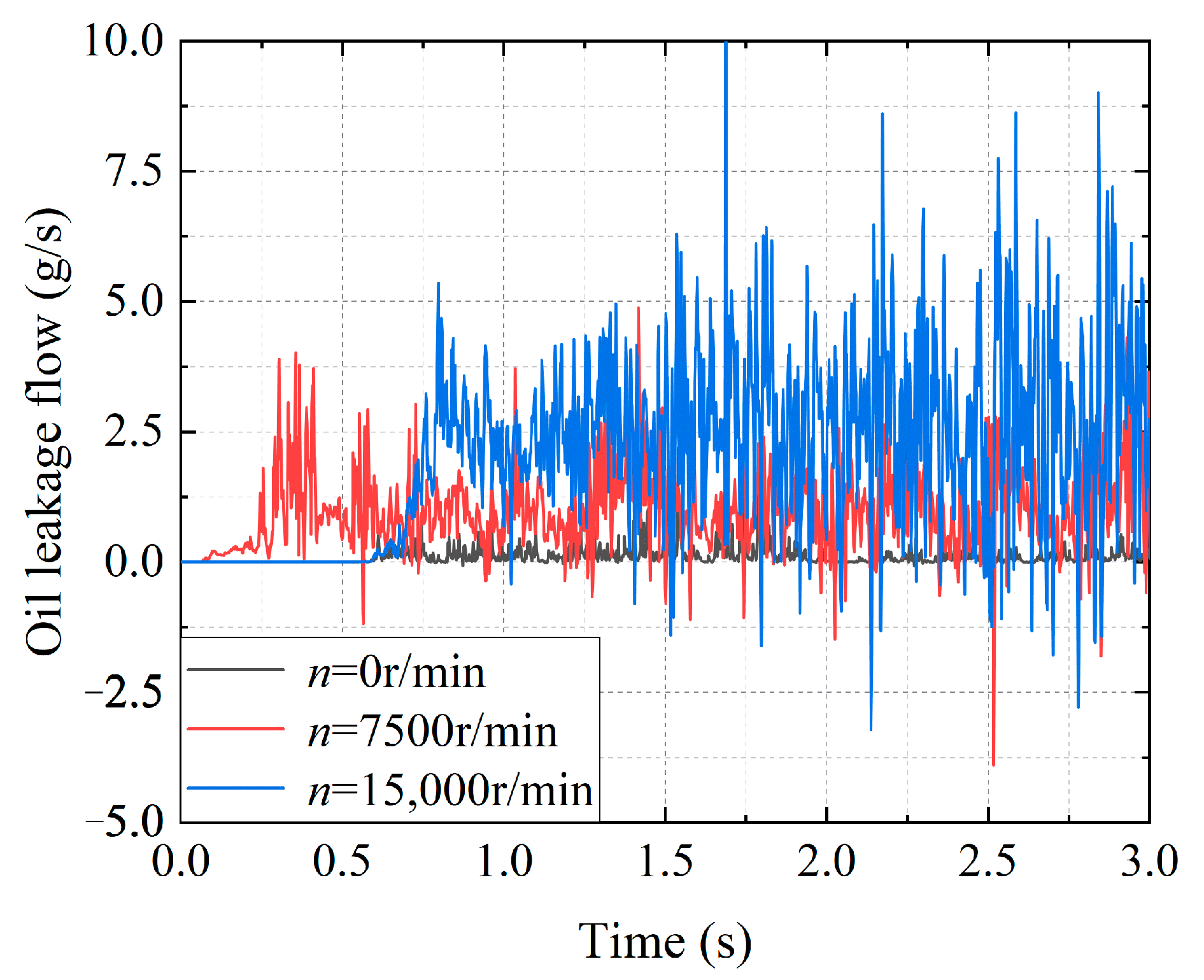
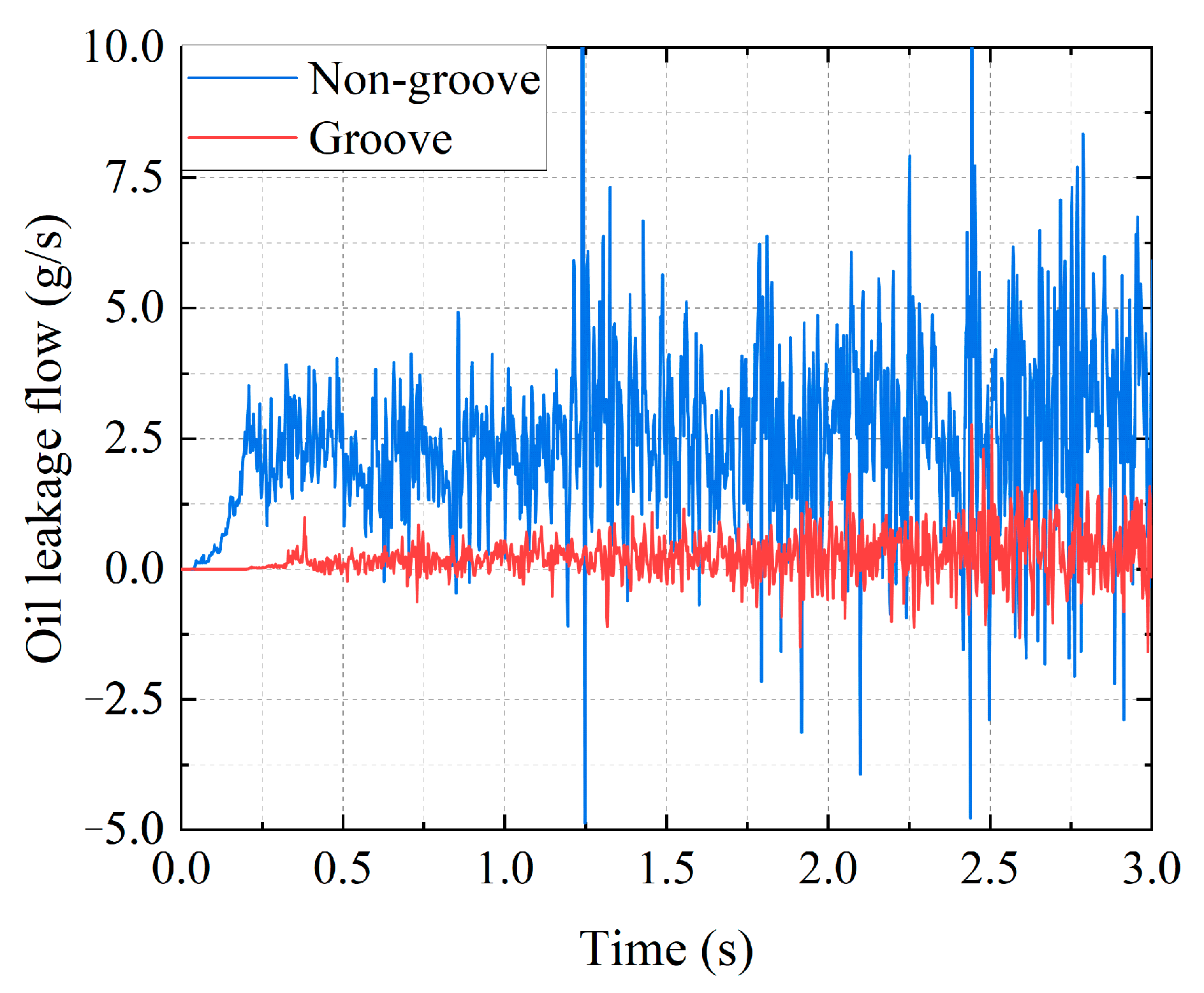



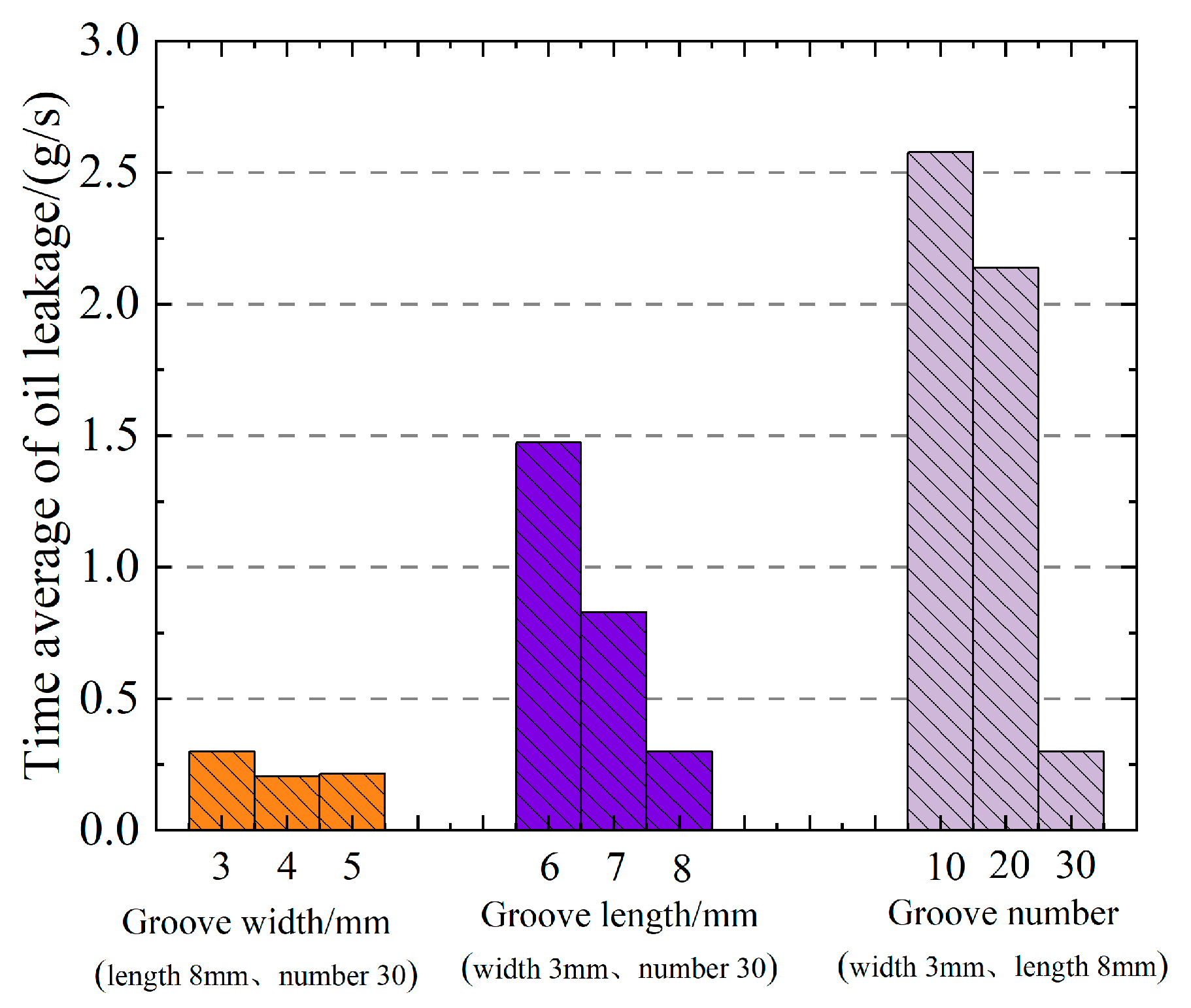

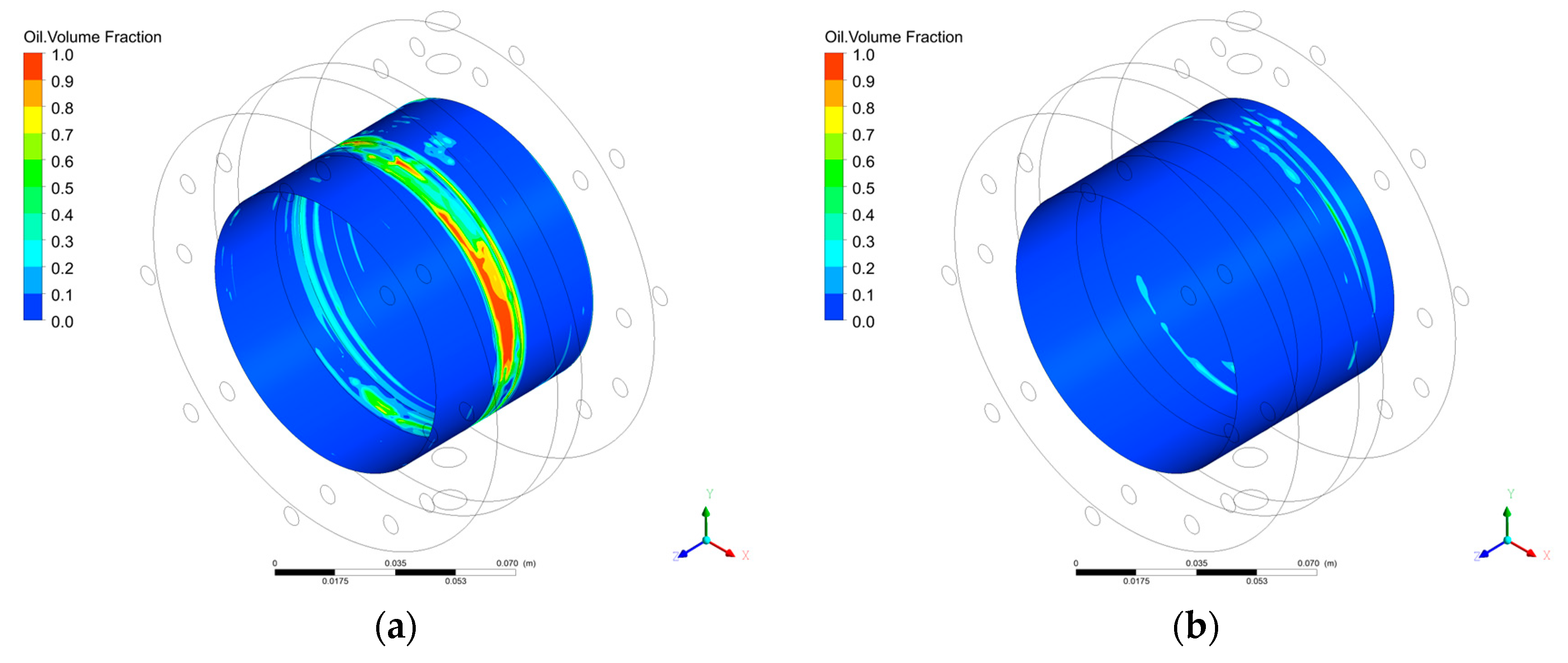
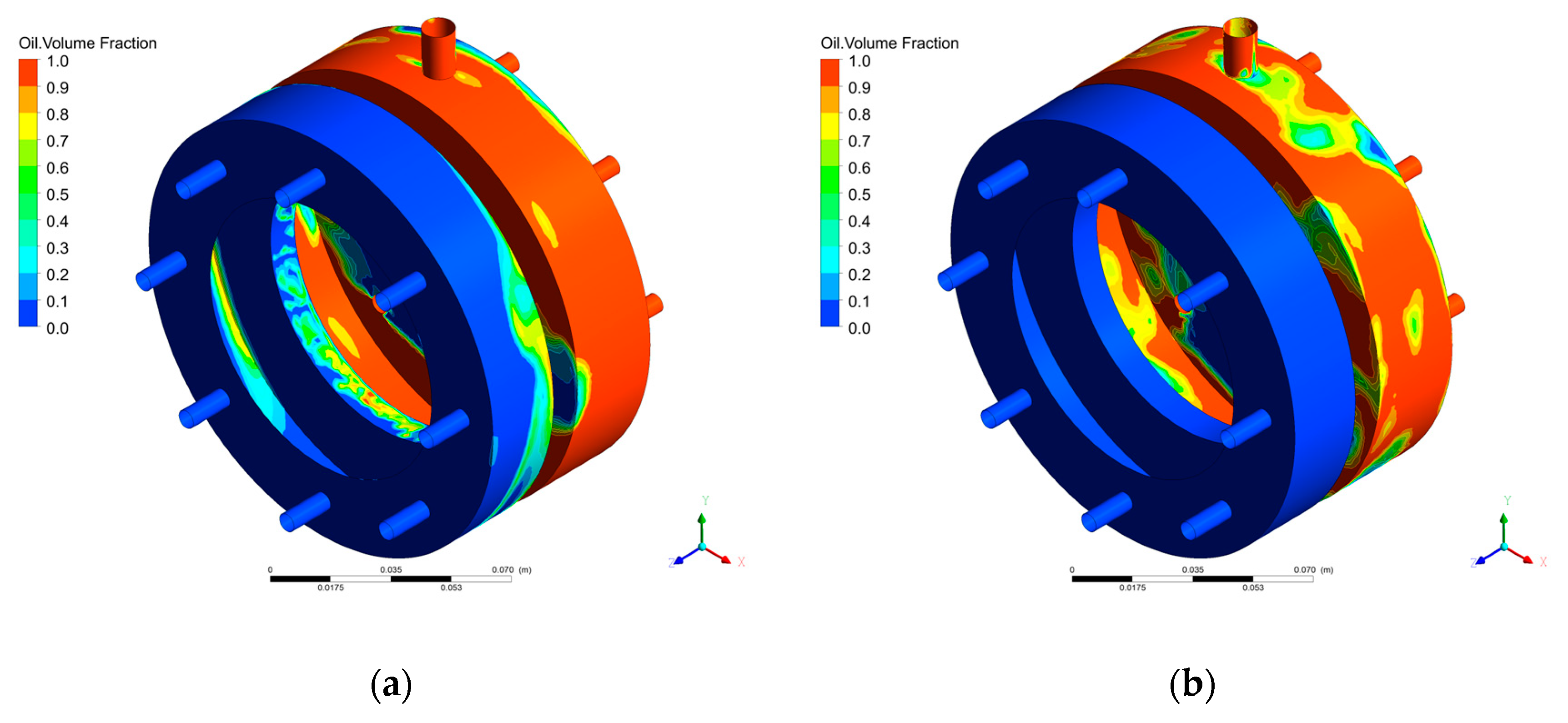
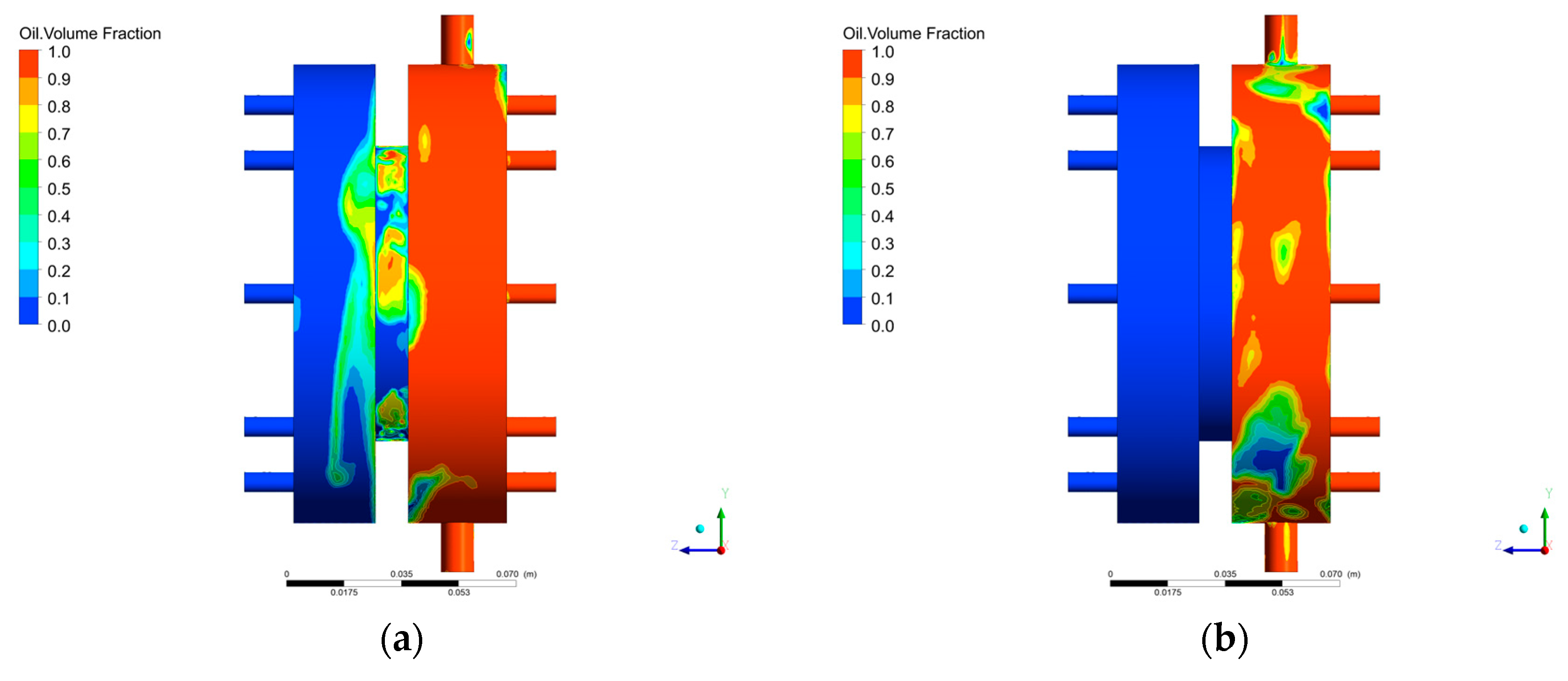


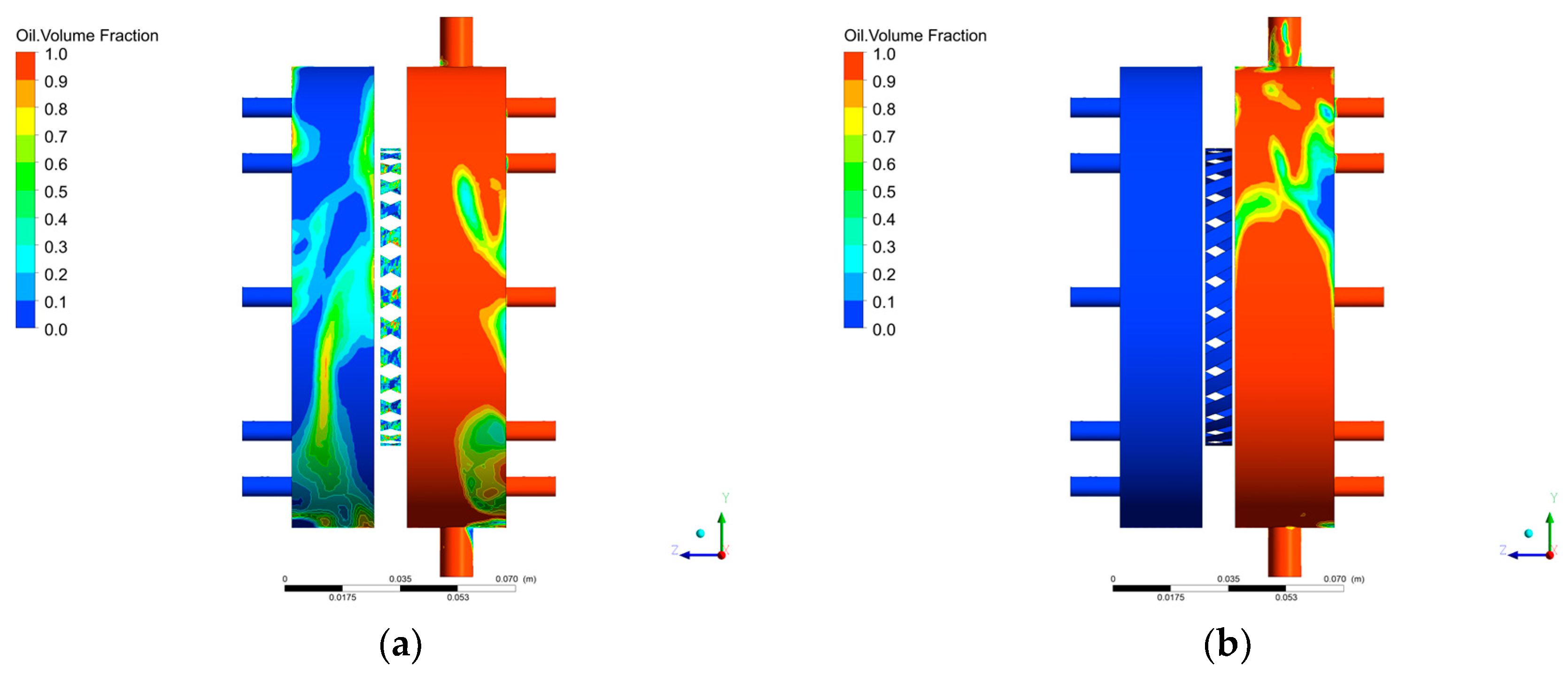
| Parameter | Value |
|---|---|
| Oil cavity, gas cavity diameter/mm | 155.00 |
| Leakage gap size/mm | 0.05~0.20 |
| Sealing gap length/mm | 10.00 |
| Oil cavity height/mm | 155.00 |
| Gas cavity height/mm | 90.00 |
| Inlet hole diameter/mm | 8.00 |
| Parameter | Value |
|---|---|
| Inlet total pressure/Pa | 200~2000 |
| Outlet static pressure/Pa | 0 |
| Reference pressure/atm | 1 |
| Gravity acceleration/(m/s2) | 9.8 |
| Oil height/mm | 30~120 |
| Oil temperature/°C | 25 |
| Two-phase flow model | Mixture |
| Turbulence model | SST |
| Parameter | Value |
|---|---|
| Inside diameter Di/mm | 78.6 |
| Outside diameter D0/mm | 98 |
| Sealing gap H1/μm | 50 |
| Width of sealing cavity L1/mm | 30 |
| Width of bearing cavity L2/mm | 30 |
| Cavity height e/mm | 15 |
| Sealing length L3/mm | 10 |
| Width of groove l1/mm | 3 |
| Length of width l2/mm | 8 |
| Angle θ/° | 30 |
| Parameter | Value |
|---|---|
| Gas inlet pressure/MPa | 0.101~0.105 |
| Oil inlet mass flow/kg/s | 0.1, 0.2 |
| Ventilation pressure/MPa | 0.1 |
| Oil-return port pressure/MPa | 0.1 |
| Rotate speed/r/min | 0, 7500, 9000, 15,000 |
Disclaimer/Publisher’s Note: The statements, opinions and data contained in all publications are solely those of the individual author(s) and contributor(s) and not of MDPI and/or the editor(s). MDPI and/or the editor(s) disclaim responsibility for any injury to people or property resulting from any ideas, methods, instructions or products referred to in the content. |
© 2025 by the authors. Licensee MDPI, Basel, Switzerland. This article is an open access article distributed under the terms and conditions of the Creative Commons Attribution (CC BY) license (https://creativecommons.org/licenses/by/4.0/).
Share and Cite
Ren, G.; Wang, R.; Sun, D.; Xu, W.; Li, Y. Impact of Lubricating Oil Leakage Characteristics of a Bearing Cavity Sealing System Based on an Oil–Gas Two-Phase Flow. Lubricants 2025, 13, 384. https://doi.org/10.3390/lubricants13090384
Ren G, Wang R, Sun D, Xu W, Li Y. Impact of Lubricating Oil Leakage Characteristics of a Bearing Cavity Sealing System Based on an Oil–Gas Two-Phase Flow. Lubricants. 2025; 13(9):384. https://doi.org/10.3390/lubricants13090384
Chicago/Turabian StyleRen, Guozhe, Rui Wang, Dan Sun, Wenfeng Xu, and Yu Li. 2025. "Impact of Lubricating Oil Leakage Characteristics of a Bearing Cavity Sealing System Based on an Oil–Gas Two-Phase Flow" Lubricants 13, no. 9: 384. https://doi.org/10.3390/lubricants13090384
APA StyleRen, G., Wang, R., Sun, D., Xu, W., & Li, Y. (2025). Impact of Lubricating Oil Leakage Characteristics of a Bearing Cavity Sealing System Based on an Oil–Gas Two-Phase Flow. Lubricants, 13(9), 384. https://doi.org/10.3390/lubricants13090384





